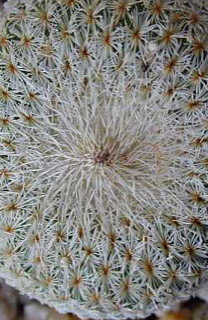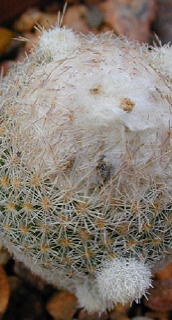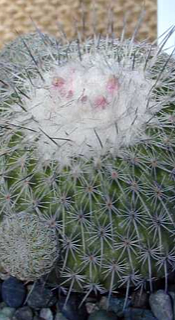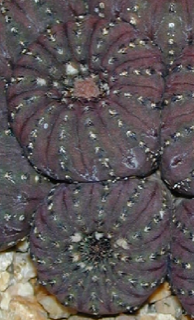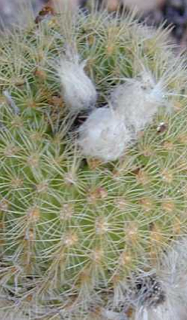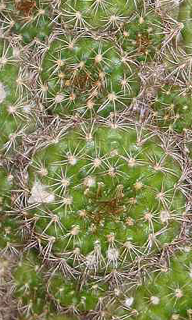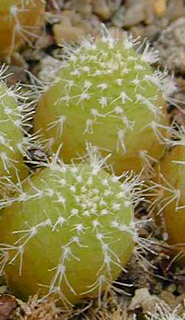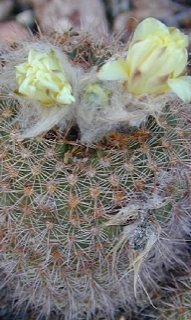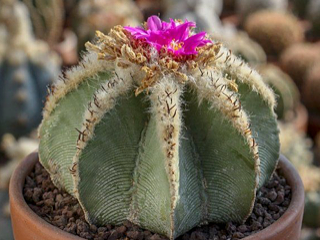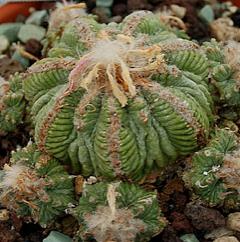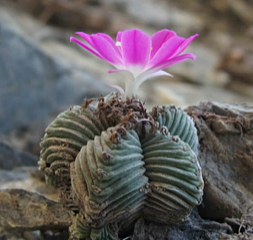Submitted by: Jim Tanner
Epithelantha (button cactus) is a genus of cactus that is native to northeastern Mexico, and in an area from western Texas to Arizona. Epithelantha has two species, Epithelantha micromeris and Epithelantha bokei. The name Epithelantha refers to the flower position near the apex of the tubercles.
Epithelantha are very small cacti with globe-shaped or cylindrical stems typically up to one inch in diameter, rarely reaching two inches long. Tiny whitish spines completely cover the surface of the stem. The flowers are also tiny, growing from the tip of the stem. Fruits are bright red.
The fruit of all species is said to be edible.
Frailea is a genus of globular to short cylindrical cacti native to Brazil. These species are cleistogamous, (being small inconspicuous closed self-pollinating flowers additional to and often more fruitful than showier ones on the same plant). They were first classified in the genus Echinocactus.
The genus Aztekium contains three species of small globular cactus. Discovered in 1929 by F. Ritter, in Rayones, Nuevo León, Mexico, this genus was thought to be monotypic (with Aztekium ritteri) until a second species (Aztekium hintonii) was discovered by George S. Hinton, in Galeana, Nuevo León in 1991.
Aztekiums are by far the most challenging and difficult cacti to grow. They are having extremely slow growth, probably the slowest of the entire Cactus family. They usually take several years for growth to be even noticeable. Once a specimen is established on its own roots it is no trouble to keep it, and becomes an easy plant to manage.
Because of the difficulty of cultivation, Aztekiums are most often grafted to hardier stock. They need good drainage and regular water in summer. Keep nearly totally dry in winter. If grafted, the plants can take a little more water. Just remember the graft stock is also a cactus and will rot if overwatered. Provide shade from midday through the afternoon. A little morning sun is OK.
LATIN LOOKUP – Loquerisne Latine (Do you speak Latin)?
The meanings of latin plant names on this page – from http://davesgarden.com/guides/botanary/
- Aztekium [az-TEK-ee-um]
Latinized form of Aztec, referring to the plant’s grooves and wrinkles which appear similar to Aztec sculpture. - castanea [kas-TAN-nee-uh]
The Latin name for chestnut. - Epithelantha [ep-ith-el-LAN-tha]
From the Greek epi (upon), thele (nipple), and anthos (flower); nipple-like flowers. - Frailea [FRAY-lee-uh]
Named for Manuel Fraile, 19th century Spanish gardener, responsible for the cactus collection of the U.S. Department of Agriculture. - hintonii [HIN-ton-ee-eye]
For George Boole Hinton, 20th century metallurgist, farmer, and plant collector in Mexico. - polycephala [pol-ee-SEF-a-la, pol-ee-KEF-a-la]
Many-headed. - pumila [POO-mil-uh]
Small, dwarf. - ritteri [RIT-ter-ee]
Named for Friedrich Ritter, early 20th century German cactus collector.
